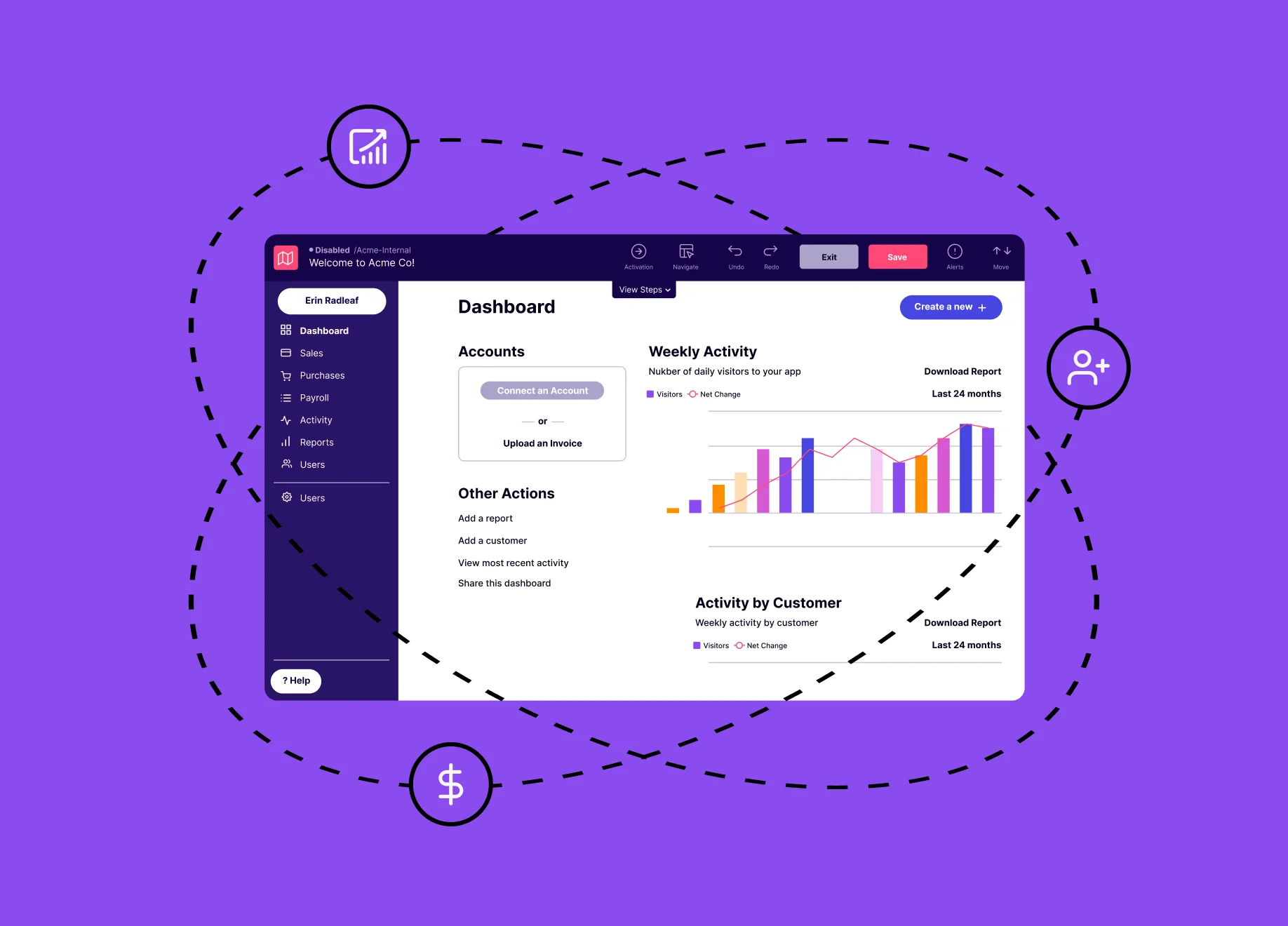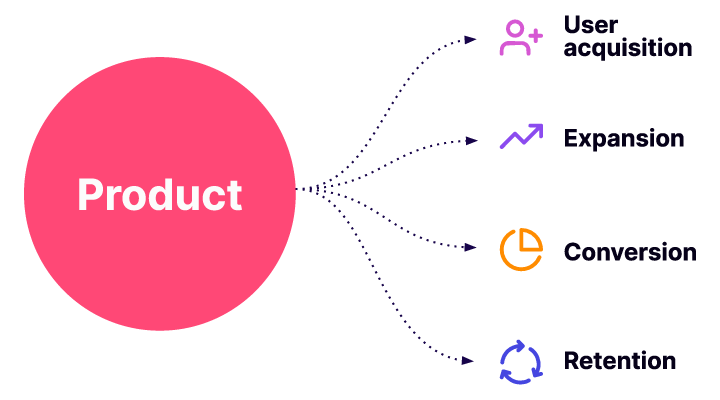目次
プロダクト主導の成長とは?
Product-led growth describes a business strategy that places a company’s software at the center of the buying journey—and often at the center of the broader customer experience. A product-led growth strategy counts on the product itself—its features, performance, and virality—to do much of the “selling.”
PLGの特徴は?
PLGの主な差別化要因は、プロダクトをすべての市場投入の取り組みの中心に据えていることです。プロダクト主導の組織では、販売およびマーケティングチームは、プロダクト(およびそれが生み出す肯定的なソーシャルプルーフ)が主導権を握るように方向転換します。
たとえば、フリーミアムプロダクトを所有している企業の場合、広告キャンペーンや追加の販売員にお金をかけずに新しいユーザーを引き付けるため、プロダクト自体が販売およびマーケティングツールになります。同様に、プロダクト主導の成長(PLG)戦略では、ユーザーにプロダクトを無料で体験してもらい、十分な価値を示すことで有料版へのアップグレードを促すことがよくあります。
プロダクト主導の成長(PLG)が重要である理由
As companies grow and the amount of customers and prospects it engages with expands, a 1:1 human-to-human support and sales model becomes less and less sustainable. Product-led growth helps companies continue to scale and grow efficiently by automating some of the key onboarding, support, sales, and marketing functions and letting customers and prospects engage with them in the app itself. In doing so, it frees the humans in a company up to pursue more strategic, meaningful work while having confidence that users of all categories are getting the support and information they need. In other words, product-led growth is not a substitute for human support and ingenuity, but rather a complement to it.
プロダクト主導の成長(PLG)の歴史
The term “product-led growth” was originally coined in 2016 by Blake Bartlett at OpenView, although the principles that define it had been around before that. What drove the rise of product-led growth were companies experimenting with various ways (“freemium” product models, self-guided tours, etc.) to simultaneously grow and be profitable. In traditional growth models, growth and profitability existed as a dichotomy. Pursuing one came at the expense of the other. Product-led growth overcame this dichotomy, with the companies embracing the tactics and strategies that would become associated with the term seeing unprecedented levels of success in both.
セルフサービストライアルまたはフリーミアムは、PLGをどのように促進しますか?
Often central to a product-led growth strategy is a self-service trial or freemium option that allows a prospective customer to evaluate the product independently and without charge, bounded by time and/or functionality, and often without engaging a salesperson. This self-service approach aligns to shifting changes in buyer preferences, particularly in the research and evaluation phases of the buying journey. Many buyers want to try before they buy, relying less on a salesperson’s assistance than on their own first-hand experience with the product, in conjunction with customer and social proof that they discover via review sites and social networks.
Many companies use these trial and freemium experiences to measure product usage and engagement, scoring leads and timing and targeting conversion offers and sales outreach accordingly. Citrix, for example, used product analytics to identify a certain trial usage pattern that converted to paying customers at a higher rate than others. The team then created an onboarding flow that steered trial users toward those particular features, and was able to increase their trial conversion rate by 28 percent.
急成長中のソフトウェア企業に特化した大手VC企業であるOpenViewが、プロダクト主導の成長(PLG)とその中のフリーミアムモデルの重要性をどのように捉えているかをご紹介します。
PLGで、どのように顧客獲得コストを削減できますか?
PLG戦略は、営業チームの負担を軽減することにより、顧客獲得コスト(CAC)にプラスの影響を与えることができます。販売およびマーケティング費用は顧客獲得費用に影響するため、企業がこれらの費用を押し下げることができるほど、CACなどの効率指標がより適切になります。
プロダクト主導の成長(PLG)戦略
PLG戦略とは、プロダクトを企業の事業拡大モデルの中心に置く戦略です。戦略が実際にどのようなものになるかは、企業によって異なります。これには、新しい機能やプロダクトサービスを強調したフリーミアム版、セルフガイドデモ、アプリ内通知などのプロダクト主導の戦略を通じて達成される主要な成長指標(新規収益の割合、新規商談の見込み客の数または割合、既存アカウントの機能または使用量の増加など)の目標を設定することが含まれます。製品自体が販売、マーケティング、サポートを促進すればするほど、企業はプロダクト主導型戦略に傾倒しています。
PLGを自社のプロダクト主導戦略に結び付けるにはどうすればいいですか?
Product-led growth is a subset of a broader product-led strategy, which expands beyond the try/buy phase of a self-service buying journey to include other touch points, pre- and post sales, where the product takes center stage. For example, a product-led strategy may also mean bringing aspects of sales, marketing, service, support, and education inside the product for convenience, reduced friction, and greater contextual relevance to end users. Here, business functions and customer interactions that were previously executed through other channels converge inside the product, all toward the goal of making the product more useful, more engaging and, ultimately, more valuable for customers and end users.
プロダクト主導の成長(PLG)の例
Different companies embrace product-led growth in different ways. Citrix, for example, created personalized onboarding messaging for the free trial version of its ShareFile product based on the reasons users created an account. Using in-app messaging to speak to users’ specific needs, they saw a 60% increase in free trial conversions. Covetrus, meanwhile, leveraged product analytics to better understand user behaviors, created in-app guidance and onboarding based on those insights, and solicited feedback in-app so that customer priorities became their own.
PLGについて、もっと詳しく知りたいです。
Pendo published a comprehensive e-book on how to create a product-led organization, which is available for download here. It has also created a Product-led Hub full of insightful content on leveraging a company’s product to drive growth and a stronger business.





